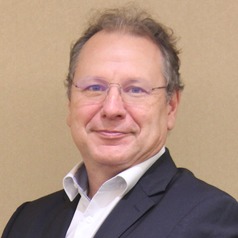
Positions
- Senior Fellow CEA Senior Fellow in the Circular Economy of Materials
- Research Director in CEA
- Co-Director of the Joint CEA/NTU Laboratory SCARCE in Singapore
- Visiting Professor at the Nanyang Technological University of Singapore
- Associate Editor at Waste Management (Elsevier)
Prof. Jean-Christophe P. Gabriel now leads an international research group delocalised on both CEA Saclay and Nanyang Technological University (2024 World’s second best university in Material Science). Members of the group and collaborators in NTU are focussing on developing e-waste as well as food (fish) waste recycling process steps. In Saclay, in addition to e-waste recycling, the group also investigate nanomaterials, their synthesis, characterisation, processing and applications.
Research
His group current fields of interest are the following:
- Waste recycling: we are developing tools and processes for improving various wastes recycling to enable more economically viable waste processing. Our efforts in this field started in 2013 and focussed at the time on an integrated microfluidic lab-on-chip that enables much faster exploration of multidimensional phase diagrams of complex fluids. Such lab-on-chip devices integrate various sensors as well as characterizations methods (such as FTIR in hollow waveguides, or X-ray fluorescence). This work was first funded, from 2013 until 2018, by the advanced ERC project REE-CYCLE, which aimed at developing new rare earth extraction/recycling processes, at least 10 times more efficient that current liquid-liquid extraction processes, where JCG was acting co-PI. Since then, within the SCARCE CEA/NTU joint laboratory in Singapore (2018-2028; budget of 20 Mn€), we have further developed the fast process development microfluidic platform as well as expanded our efforts to other process steps in the recycling of e-waste (Printed Circuit boards – PCBs, plastics from e-wastes), such has:
- PCBs and PV dismantling and associated electronic component sorting;
- Physical method based separation; Critical metals recovery and purification;
- Critical metals recovery and purification;
- Liquid-liquid and Solid-liquid hydrometallurgical recovery process steps development using the world first microfluidic platform integrating on line FTIR and XRF.
- Use of supercritical fluid as a green solvent for e-waste recycling.
- Nanomaterials: In our laboratory, among others, we specifically synthesize and characterize low dimensionality materials (0, 1 and 2D) , by all means necessary and available (from visual/microscopic observations to the use of synchrotrons for the structural investigations of materials). These materials can often be exfoliated/dispersed in solution leading to some complex/colloidal fluids, exhibiting a very wide range of fascinating behaviours (see here for a video of my presentation on the subject at NTU’s workshop on polyelectrolytes). They can also be integrated into various types of devices, hence the following topic.
- Integration:
- Thanks to the awarded ANR Project 2D-MEMBA (2022-2025): we integrate nanomaterials for the making of less power-hungry membranes for the purification of water.
- Thanks to the awarded ANR Project 4WATER (12/2017-12/2022) (see video of presentation): we are elaborating new and cheap multi-target chemical sensor arrays for the continuous monitoring of groundwater quality. Using a microelectronic approach, the sensors will be based on functionalized nanomaterials and that will target various ions selected for their relevance as regards the quality of fresh water.
For more details on our research group look here.
Other duties
- Member of the Scientific Council of Arc Nucleart
- Editorial duties:
- Associate Editor, Waste Management (IF: 7.1) (01/2025-present)
- Guest editor, Waste Management (IF: 7.1) special issue on “Artificial intelligence/machine learning in waste management“. Submission Deadline is 31/12/2024.
- Editorial board member of Nanomaterials, MDPI (2022-present)(and co-guest editor of special issue on “Nanofiltration Membranes”)
- Editorial board member of Applied Sciences, MDPI (2021-2023)
- Editorial board member of International Journal of Nanotechnology, Inderscience Publishers (2005-present).
Results highlights
- 23/09/2025: Our latest article, entitled « Advancing Sustainable Closed-Loop Solutions: Supercritical Carbon Dioxide Technology for Aquatic Biological Waste Valorization. » authored by Qiqi Sun, Jean-Christophe P. Gabriel, Tan Lay Poh has just been accepted and put online (as pre-proof) in Applied Food Research https://doi.org/10.1016/j.afres.2025.101384
- 01/09/2025: I have been awarded the title of “Senior Fellow in the Circular Economy of Materials” at CEA. The title of ‘Senior Fellow’ represents the highest level of expertise recognize by CEA for one of its employees. It is awarded to only a few dozen of its researchers. In their area of expertise, Senior Fellows are required to represent and promote the CEA’s general policy and provide scientific and technical support for analysing the organisation’s position on strategic projects. They are likely to represent the CEA in its institutional, academic and industrial interfaces. They also contribute to cross-functional missions related to the organisation’s scientific and technical foresight, which must be carried out in an international context. For more details, see my linkedin post on the matter.
- 07-10/07/2025: 2d Bernard Bigot Conference in Cadarache, France, where I acted as the Chairman of the organizing committee. All conferences and lectures have been recorded and are, or will soon be, available on my youtube channel. They will ultimately be hosted here.
- 30/06/2025-04/07/2025: Our #SCARCE research fellows Drs Christine Ng & Dr. Pallab Das, senior research fellow Dr. Dong Xia and Research Assistant Professor Han Bo where each granted an Oral presentation at ICMAT in Singapore.
- 03/07/2025: Keynote presentation at the World Filtration Congress entitled “Novel and Highly Selective Membranes Based on 2 & 3D Porous Nanomaterials”. Jean-Christophe P. Gabriel, Sarah M. Chevrier, Bo Han, Emilie ROLLAND, Thibault Rosier, Fabien L. Olivier, Lina Cherni, Kunli Goh, Chuah Chong Yang, Guillaume Zante, Qingyu Yan
- 01/07/2025: Our group member and Ph. D. student Emilie Rolland, gives an oral presentation at the World Filtration Congress entitled “Novel and Highly Selective Membranes Based on 2D Porous Nanomaterials”.
- 17/06/2025: gave an invited lecture at the Microfluidics25 summer school, Cap Ferret, France, entitled: “Analytical chemistry using microfluidics: X-ray fluorescence analysis and solvent activities”.
- 12-13/06/2025: Together with my colleague Dr. Adrien Stolidi, we presented the RecyX demonstrator at the LIST Tech Days 2025.
- 10/06/2025: Our CEA/LIST‘s collaborator Aurore Vazzoler presented a poster at ANIMMA 2025 in Valencia – Spain, entitled “Development of an X-ray fluorescence spectro-imaging instrument, based on Timepix3 counting chip, adapted for electronic waste sorting”, authored by A. Vazzoler, T. Rosier, A. Stolidi, J.C. Gabriel, Q. Gendre, G. Amoyal.
- 26/05/2025: I presented an invited talk at the e-MRS 2025 Spring meeting in Strasbourg, Symposium W on the Indo-Europe Joint Forum on Circular Economy through Urban Mining and entitled: “Closing the materials cycle in WEEEs: the recovery of lost critical metals” authored by Dong Xia , Han Bo, Nicolas M. Charpentier, Thibault Rosier, Guillaume Zante, Yan Qingyu, Jean-Christophe P. Gabriel.
- 14/04/2025: Publication of our work on the synthesis of materials from the dissolution juice of photovoltaic panels and their use in the production of membranes for the separation of copper and silver. See:« From electronic wastes to efficient and specific filtration membranes: A photovoltaic upcycling case enabling silver urban mining. » Bo Han, Ying Sim, Qingyu Yan, Nripan Mathews, Jean-Christophe P. Gabriel, Journal of Cleaner Production, 505, 145528 (2025).
- 31/03/2025: Publication of our work on selective membranes enabling silver recovery from capacitors. See: « Enhanced Silver Recovery from Electronic Wastes Using Ionic Liquid-Integrated Nanocomposite Membrane. » Bo Han, Ziyang Liu, Dong Xia, Guillaume Zante, Qingyu Yan, Jean-Christophe P. Gabriel, Submitted to Separation and Purification Technology, 366 132689 (2025). This article is part of a special issue entitled: ‘Ionic liquids-assisted advanced separation technology’
- 04/03/2025: Gave an invited lecture at the occasion of the celebration of 60 years of diplomatic relations between France and Singapore: Sustainable development and the circular economy in France and Singapore; organized by the Association des auditeurs IHEDN région Paris Ile-de-France, at the Ecole Militaire, Paris.
- 05/12/2024: Invited webinar video-recorded (in French) by the GDR Prométhée, entitled “An instrumented microfluidic platform for the rapid study and development of hydrometallurgical processes“, co-authored by Johannes Theisen, Ange Maurice, Christophe Penisson, Fabien Olivier, Sarah Chevrier, Thomas Zemb and Jean-Christophe P. Gabriel.
- 26/11/2024: CEA has a stand at POLLUTEC 2024, come and see us there to discuss our work on electronic waste recycling.
- 15/11/2024: Here is our latest review on a rising new technology of membranes, that mixes #nanomaterials with #polymers. Will it make it to the #market? Published in open access in Resources, Environment and Sustainability and entitled “Thin-film nanocomposite (TFN) membrane technologies for the removal of emerging contaminants from wastewater.”
- 30/08/2024: IRAMIS’ Highlight on our latest article on Lanthanide Extraction using supercritical CO2.
- 22/08/2024: In our latest article entitled “Maximised lanthanide extraction by supercritical CO2 extraction using fluorinated organophosphate extractants;” we show that carbon dioxide can successfully be used, instead of organic solvents, to extract lanthanum salts from a solid substrate. This article was published in the new journal: ACS Sustainable Resource Management and was selected as on of its covers.
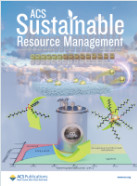
- 14/08/2024: Our latest review article entitled « Drivers and pathways for the recovery of critical metals from waste printed circuit boards. », was just published today in Advanced Science and made the cover. It is in open access = available to all.

- 20/06/2024: Was honoured to be invited at the FRANCE-SINGAPORE CIRCULAR ECONOMY FORUM and to participate to their “Panel discussion on industrial goods” together with
- Mrs Karine Alquier-Caro – Area VP Southeast Asia at LEGRAND Group
- Mrs Valerie Patuel – CEO Safran Singapore & Asean Regional Delegate – Managing Director Safran Helicopter Engines Asia
- Mr. Fabrice Espinosa – Senior Advisor CARBIOS
- 19-21/06/2024: We are showcasing SCARCE’s effort on the recovery of lost metals from printed circuit boards with a booth at CleanEnviro Summit Singapore 2024, and are featured in the Summit’s key highlights
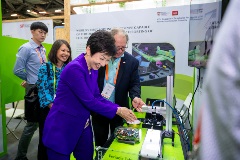
and homepage banner. Photo Gallery.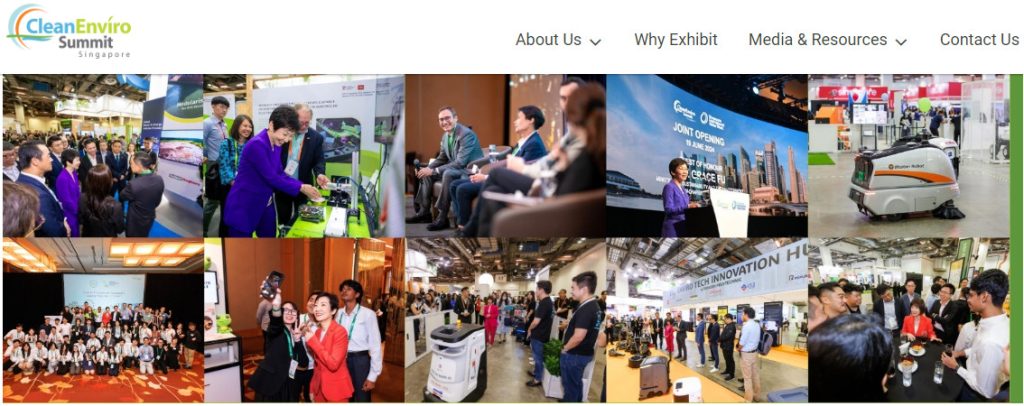
- 19/06/2024: Today, we had the privilege to present some highlights of our work at the joint NTU – CEA SCARCE laboratory to Singapore’s Minister for Sustainability & the Environment Grace Fu, and Ambassador of France Minh Di Tang. See Here for the French Ambassy’s post and pictures of the visit on linkedIn.
- 23/05/2024: Our latest and first “first author” article my former PhD student, Dr. Sarah Chevrier, entitled “Gas Permeation through V2O5 Nanoribbons-Based Membrane” was just published on line. It is published in the new journal Advanced Materials Interfaces and is available for all to read (in open access). It is our fist article on the integration of the 2D lyotropic mineral materials that we have beed working on for decades, for the making of membranes, here for gas separation. These first and very promising results are highly encouraging and confirm our interest in the field.
- 13/05/2024: Our article on “Printed circuit board recycling: a focus on a novel, efficient and sustainable process for spent critical metals recovery“, was published on line today, in open access and available for all, in the Comptes Rendus, Chimie, of the French Academy of Science. It summarize our approach and proposed shift in paradigm in the recycling of PCD to allow for the recycling of currently lost critical metals.
- 03/04/2024: Today, Ms Sarah Chevrier’s received many praises and congratulations from the Jury following her Ph.D. defence today. She has therefore been granted the diploma of Doctor of the University Paris Saclay, France’s best scientific University and will now pursue her career at the Air Liquide’s research centre. A pdf version of his official PhD Manuscrit is available here .
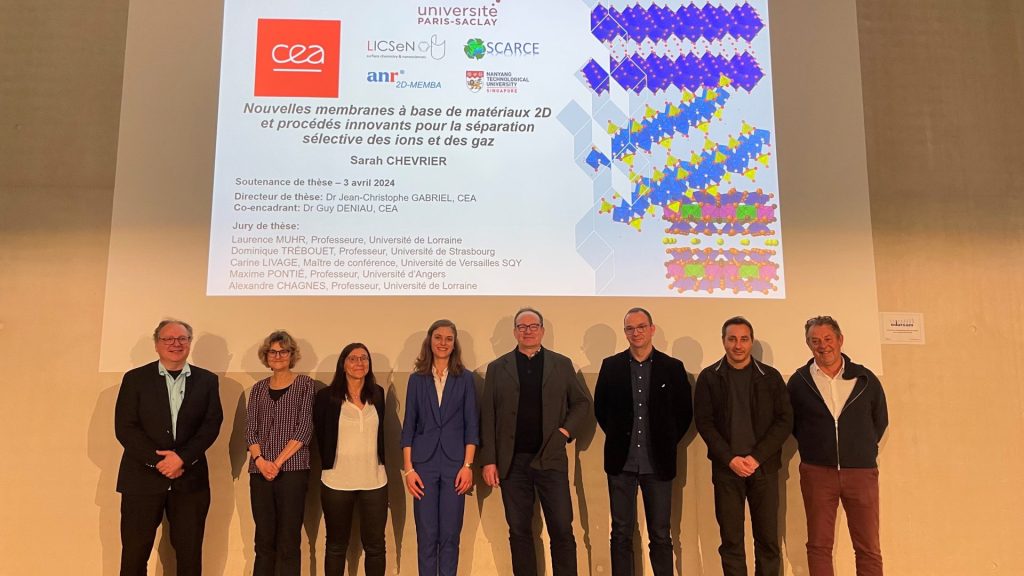
- 31/01/2024: Congrats to Mr Nicolas Charpentier for his exemplary defence of his multidisciplinary Ph.D. work in front of a large jury of many competences. He has been granted the diploma of Doctor of the University Paris Saclay, France’s best scientific University and will now pursue his academic career as a postdoc at the European Synchrotron Radiation Facility (ESRF). A pdf version of his official PhD Manuscrit is available here .
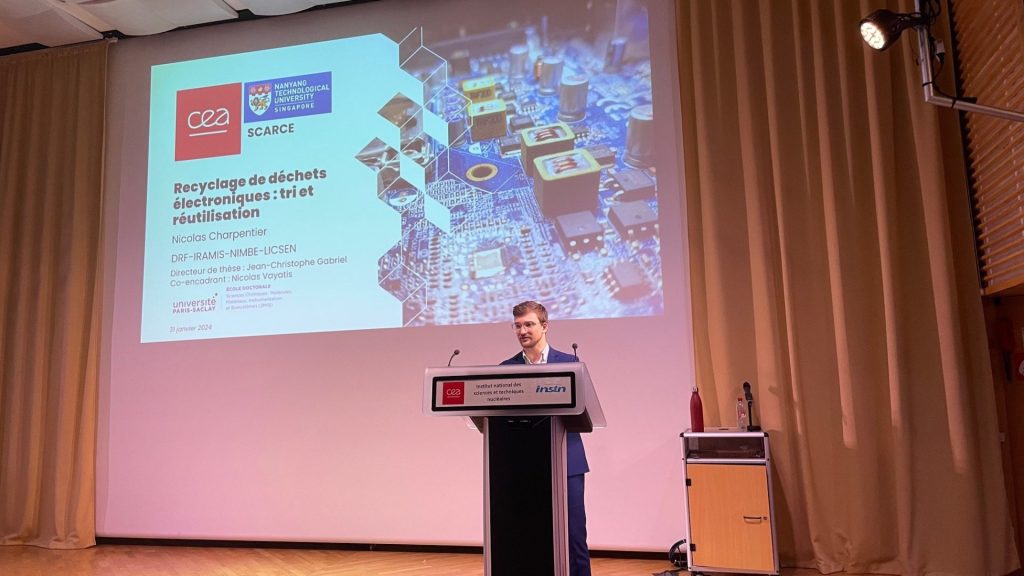
- 25/11/2023: Our latest article dealing with the crystalline restacking of 2D nanosheets from solution published in Nanoscale (Q1, IF=5.8) can be found in open access here
- 20/10/2023: Congrats to Ms. Yuemin Deng who brilliantly defended her PhD work in front of a large and expert jury. She has been granted the diploma of Doctor of the University Paris Saclay, France’s best scientific University. And best wishes for a successful career with your new employer: ECOLOGIC SAS. A pdf version of his official PhD Manuscrit is available here .

- 19/09/2023: Today, Mr. Fabien Olivier made us all proud with the excellent defence of his PhD work on the fast development of hydrometallurgy process using a microfluidic platform. Since his Ph.D. took place in the framework a Joint PhD program, he has been granted a Doctorate diploma from both the University Paris Saclay, France’s best scientific University as well as the Nanyang Technological University (NTU) (ranked world’s 2nd best university in Material Sciences in 2024). Congrats to Dr. Fabien Olivier and good luck with your new employer, ERAMET! A pdf version of his official PhD Manuscrit is available here.
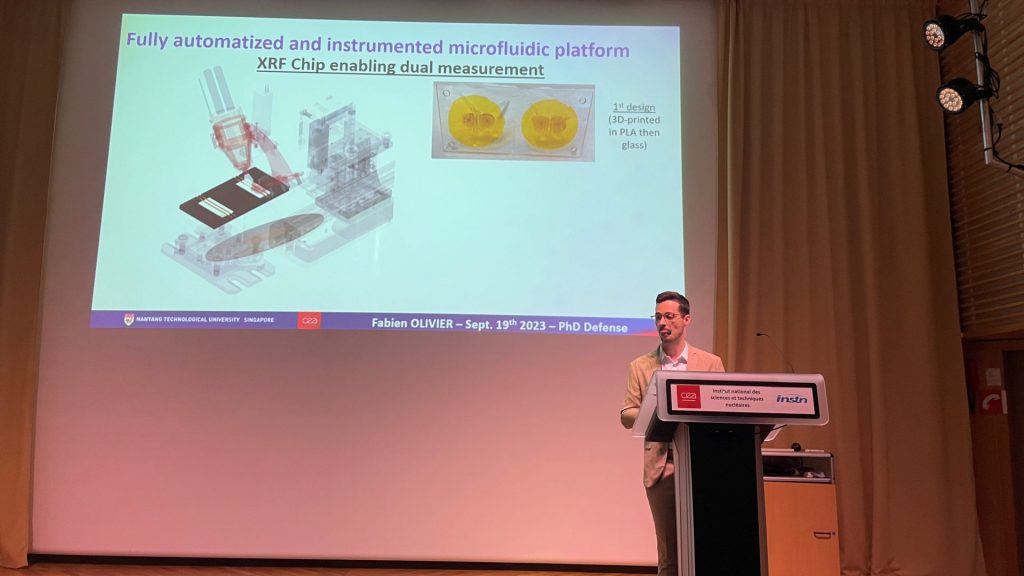
- 20/06/2023: Our latest article, arising from the CEA/NTU joint laboratory SCARCE, is “In Press” in Chemical Engineering Journal, can be downloded free of charge from here for the next 50 days. It is entitled: “Enhanced extraction of brominated flame retardants from e-waste plastics” . Enjoy!
- 12/05/2023: Just fresh out of the press our detailed article on how to recover strategic metals currently wasted in the recycling of Spent Printed Circuit Boards, entitled: “Urban mining of unexploited spent critical metals from E-waste made possible using advanced sorting“. Can be dowloaded for free for the next 50 days here.
- 14/04/2023: We published today our work on “Tailorable metal-organic framework based thin film nanocomposite membrane for lithium recovery from wasted batteries.” in the journal Separation and Purification Technology (Q1, IF =8.1).
- 24/03/2023: We just published our latest article on Carbon Nanotube Field Effect Transistor based, as a pH sensor.
- 26/01/2023: Our group member, Ms Lina Cherni, defended today her PhD in front of a Jury of her peers. One should now refer to her as Dr. Lina Cherni 🙂 A pdf version of her official Ph.D. manuscrit can be found here.
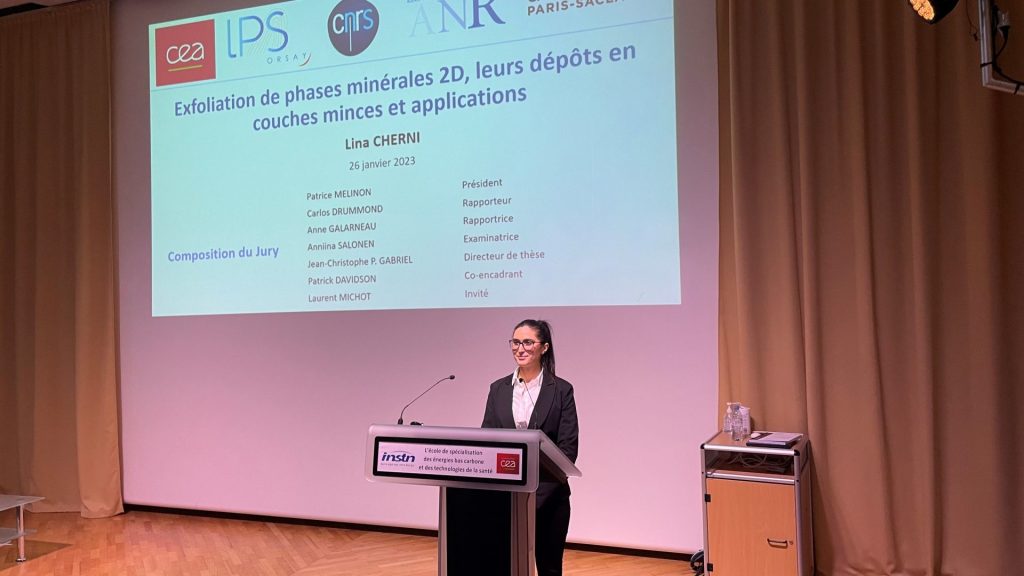
- 22/11/2022: We just published an article on the Solid – Liquid separation of metals (iron and rare earth). See here for a highlight.
- 05/08/2022: We recently proved that some multi layers ceramic capacitors (MLCC) could be upcycled into effective catalysts for the anodic oxygen evolution reaction.
- SCARCE’s findings will be presented at the World Materials Forum (June 16-18, 2022), Nancy, France; see video presentation.
- Microfluidic investigations of the kinetics and thermodynamics of the liquid-liquid extraction of various metals drives the attention to very slow kinetics that can lead to errors in terms of Free Energies calculations.
- Sustainable route for Nd recycling from waste electronic components featured with unique element-specific sorting enabling simplified hydrometallurgy
- Direct reuse of electronic plastic scraps to direct stem cell growth and differentiation
- Fine tuning of the structural colors of photonic nanosheet suspensions by polymer doping and journal’s back cover
- How to extract more value out of a PCB? Dismantle and sort smartly all electronic components.
- New technologies to recycle electronic waste
- On-line spectroscopic study of brominated flame retardant extraction in supercritical CO2.
- First online X‐ray fluorescence characterization of liquid‐liquid extraction in microfluidics.
- Mesurement of solvent mixture activities using Substrate-Integrated Hollow Waveguide Infrared Spectroscopy with Integrated Microfluidics (published, in collaboration with Boris Mizaikoff from Ulm University) and their simulation (published, in collaboration with JF Dufrèche’s group from ICSM).
- Discovery of the first lamellar phase made of covalent nanosheet
- Use of inorganic mesophases for the measurement of residual dipolar couplings of biomolecules by NMR (ref. 22, 24, 32).
- Synthesis of highly ordered nanocomposite and mesoporous materials (oxides) using self-assembly properties of nanomaterials (ref. 27, 29).
- Functionalization of rhenium nanoclusters (ref. 2, 3, 10, 15, 18, 23). Investigation of their possible use in radio-immunotherapy.
- Exfoliation of inorganic materials for the synthesis of nanostructures. This allowed us to discover highly flexible inorganic polymers as well as polymers that coil into nanotubes (ref. 22, 25).
- Synthesis of all-inorganic liquid crystals based on nanotubes, nanowires, nanorods and nanosheets (oxides, sulfides). Characterization by SAXS, TEM, rheometry (ref. 1, 4, 13, 21, 24, 26, 28, 34).
- Self-assembly of clay nanosheets: First clear-cut demonstration of the mesogenic (liquid crystal) properties of clay minerals. This work has been considered a milestone in the field as it generated a refutation of the house of cards model for aqueous clay suspensions (ref. 8, 26).
- Structure determination of high surface area nanoporous materials (and their templates) for catalytic applications (ref. 7, 9, 12).
In the NEWS
- 26-27/11/2024: we will be showcasing our latest technologies in recycling electronic waste at CEA’s booth at POLLUTEC 2024 in Paris. Come to meet and discuss with us. We have many technologies to licence, scale up and bring to the market, that are great business opportunities.
- 30/08/2024: IRAMIS’ Highlight on our latest article on Lanthanide Extraction using supercritical CO2.
- 19 to 21/06/2024: SCARCE showcased its latest technological developments in the recycling of Printed Circuit Boards with a booth at the CleanEnviro Summit Singapore (CESG) 2024. A highlight was the joint visit of the booth by the French Ambassador, Ms. Minh-di Tang, and Ms Grace Fu, Singapore’s Minister for Sustainability and the Environment where myself together with Dr. Han Bo (in the picture) and Dr. Pallab Das demonstrated our approach for the recycling of lost metals with our tradeshow electronic component sorting demonstrator.
- 26/04/2024: Today is the World IP Day (Intellectual Property day). For this special occasion, one of the technologies developed by our team in the CEA and Nanyang Technological University Singapore joint SCARCE laboratory is highlighted in this video.
Main contributors to this technology: Andrea Brambilla, Ange A. Maurice, Nicolas Charpentier, Colin LOCOGE & PALLAB Das
#WorldIPDay #IntellectualProperty #Innovation #SustainableDevelopmentGoals #Singapore #Ewaste #Recycle #WEEE #ewaste #criticalmetals - 21/03/2024: My interview by national daily French newspaper Liberation entitled “Déchets électroniques : «Le recyclage est utile mais il ne suffira pas»“.
- Le CEA et la NTU Singapore renforcent leurs partenariats? And its english version “NTU deepens research and academic ties with France” here.
- Our work and most recent endowment of SGD 17 Million, highlighted in Singapore’s Straits Time, together with an interview of its co-director, look here.
- The CEA/NTU joint laboratory SCARCE (p. 42) as well as our fast process development microfluidic platform (p. 20) are highlighted in two different articles in the latest “Clefs CEA” issue, dated February 2023 (in French).
- SCARCE work and lab’s Booth at CleanEnviro Summit 2022 in Singapore, highlighted in TV News segment on Singapore ‘s CNA and Channel 5 (at timestamp 2’03”), as well as via a 20 minutes live interview of myself on Tech Talk of radio channel CNA938. (at Sg local time 3:11 pm, to be adjusted to your local time = 9:11 am in France for example).
- IRAMIS highlight: “Le CEA et la NTU résolvent ensemble des problématiques clés pour un meilleur recyclage des déchets électroniques”
- Part of our work on recycling of electronic waste was presented on November 8th, 2021 at the French Academy of Sciences. It can be viewed on the #AcadémiedesSciences ‘ Youtube channel here.
- Our work highlighted in: “Une transition vers l’économie circulaire”, in l’Edition de l’Université Paris-Saclay, Summer 2021
- Our work highlighted in: “Recycler les déchets électroniques” in Les Défits du CEA, spécial CEA’s 75 years anniversary issue (p. 35)
- CEA-NTU SCARCE featured in a Channel News Asia documentary
- SCARCE : 18 mois de collaboration entre une université de Singapour et le CEA
- SCARCE laboratory featured in National Geographic’s documentary “Green Heroes Part 2 – E-Waste Recycling”
- News on the Inauguration of SCARCE laboratory in NTU (selection):
- Cérémonie de lancement du projet Scarce entre NTU et NEA de Singapour et le CEA
- Channel News Asia: New S$20 million lab to develop less toxic e-waste recycling methods
- French-Singaporean Cooperation on E-Waste
- Signature de cinq accords en matière de coopération universitaire et scientifique
- French-Singaporean Cooperation on E-Waste
CV
Dr. Jean-Christophe P. Gabriel is Research Director and one of CEA’s Felow in Chemistry. Since September 2020, his French laboratory is located in CEA Saclay with a special focus on 1D and 2D nanomaterials and their applications as well as on the development of waste recycling processes. He is also currently a visiting Professor at NTU where he serves, since August 2018, as co-director of the NTU Singapore CEA Alliance for Research in Circular Economy (SCARCE), CEA’s first joint laboratory outside French territory (comprising ~25 postdocs and Engineers). There he directly co-supervise, together with Prof. Alex Yan Qingyu, a team of ~10 postdocs, PhDs, Engineers and interns in the field of e-waste and Prinited Circuit Board recycling.
He first joined the French Alternative Energy and Atomic Energy Commission (CEA) in 2007 as CEA/LETI institute’s “Beyond CMOS” program manager as well as the business director of the academic – industry Caltech – LETI alliance, which led, years later, to the creation of the Startup Apix Technology.
From 2009 to 2016, he became deputy director of CEA’s Nanoscience program (budget: 1 M€/year), help defining, financing, networking, growing, communicating and prospering seed projects and young researchers. Hence, in this role of scientific project manager, he helped the maturation of TRL=0 ideas, trained young researchers in writing very high impact factor articles (Nature and co), co-invented various technologies, helped on building successful project proposals (ERCs), as well as on the germination and business model definition at pre-seeding round of future startups such as NawaTechnologies, Aledia, cell&soft), and served in various the ANR in various roles, such as expert, project selection panels or committees.
In parallel, from 2013 to 2018, he was co-principal investigator of the REE-CYCLE advanced ERC project (2013-2018), that aimed at developing new rare earth extraction/recycling processes, at least 10 times more efficient that current liquid-liquid extraction processes. In his laboratory in Grenoble, created in 2014, he was developing integrated microfluidic lab-on-chip that enable much faster exploration of multidimensional phase diagrams of complex fluids, therefore enabling fast process development. Such lab-on-chip devices integrate various sensors as well as characterizations methods (such as FTIR in hollow waveguides, or the world first microfluidic-integrated Xray fluorescence spectrometer dedicated to hydrometallurgy studies).
Former student at the “Ecole Normale Supérieure” in Paris, he received his Ph.D. (1993), supervised by Dr. Patrick Batail, from University Paris-Saclay (formerly Orsay University) and his Habilitation from Grenoble-Alpes University (Formerly Joseph Fourier University). He completed his PhD training with two postdocs. The first in Risø National Laboratory, Denmark, under the supervision of Prof. Klaus Bechgaard, the second at the Material Research Laboratory a the University of California Santa Barbara, under the mentorship of Prof. Anthony K. Cheetham.
His career is a mixed academic – industrial one. He indeed started his tenured career with Prof. Jean Rouxel and Dr. Patrick Batail at CNRS (4 years at Jean Rouxel Institute, IMN, Nantes) followed by 6 years in the Californian startup Nanomix (nanomixdx.com), where he was one of the first employee. In this UC Berkeley’s spinoff he helped in the technology transfer of nanomaterials, hydrogen storage and carbon nanotubes technologies, helped raised $34 million of venture capital money and with his team was the first to put an integrated nanotube based electronic device on the market (a hydrogen sensor, in 2005). Since he left the company in August 2007, Nanomix has marketed fast electronic diagnostic tools (Ebola, COVID-19 etc.) based on, among others, patents that he co-invented.
Jean-Christophe has published more than ~ 90 papers in international peer reviewed journal and is co-inventor on more than 45 patents and patent applications, dealing with nanomaterials (carbon nanotubes, graphene) applications (sensors, H2 storage) and waste recycling processes.
Other profiles:
- My Jean-Christophe P. Gabriel youtube channel
- LinkedIn <= look here or subscribe there for more timely news
- For access to my publications, patents and more, look here: Archive ouverte – HAL
- Google Scholar
- Research Gate
- ORCID: 0000-0002-0194-683X
- Tweeter: @dr_jcpgabriel
- Research.com ‘s <= For “Best Scientists” ranking
Recent Publications & Patents
2025
- « Advancing Sustainable Closed-Loop Solutions: Supercritical Carbon Dioxide Technology for Aquatic Biological Waste Valorization. » Qiqi Sun, Jean-Christophe P. Gabriel, Tan Lay Poh Applied Food Research (online 23/09/2025 as pre-proof) https://doi.org/10.1016/j.afres.2025.101384
- « From electronic wastes to efficient and specific filtration membranes: A photovoltaic upcycling case enabling silver urban mining. » Bo Han, Ying Sim, Qingyu Yan, Nripan Mathews, Jean-Christophe P. Gabriel, Journal of Cleaner Production, 505, 145528 (2025). https://doi.org/10.1016/j.jclepro.2025.145528
- « Enhanced Silver Recovery from Electronic Wastes Using Ionic Liquid-Integrated Nanocomposite Membrane. » Bo Han, Ziyang Liu, Dong Xia, Guillaume Zante, Qingyu Yan, Jean-Christophe P. Gabriel, Separation and Purification Technology, 366 132689 (2025). https://doi.org/10.1016/j.seppur.2025.132689 This article is part of a special issue entitled: ‘Ionic liquids-assisted advanced separation technology’ Separation and Purification Technology
2024
- « Thin-film nanocomposite (TFN) membrane technologies for the removal of emerging contaminants from wastewater» Bo Han, Jean-Christophe P. Gabriel, Journal of Cleaner Production, 144043 (2024). https://doi.org/10.1016/j.jclepro.2024.144043
- « Printed Circuit Board Recycling: Focus on a Novel Efficient and Sustainable Process for Spent Critical Metals Recovery. » Nicolas M. Charpentier, Dong Xia, Jean-Christophe P. Gabriel, Comptes Rendus Chim. 27(S4) pp. 5-15, (2024). https://doi.org/10.5802/crchim.291 An article part of Special Issue: “GDR Prométhée – French Research Network on Hydrometallurgical Processes for Primary and Secondary Resources”; Guest editors: Laurent Cassayre and Hervé Muhr.
- « Drivers and pathways for the recovery of critical metals from waste printed circuit boards. » Dong Xia, Carmen Lee, Nicolas M. Charpentier, Yuemin Deng, Qingyu Yan and Jean-Christophe P. Gabriel, Adv. Sc. 30, 2309635 (2024). (cover) https://doi.org/10.1002/advs.202309635
- « Gas permeation through V2O5 nanoribbons-based membrane. » Sarah M. Chevrier, Kunli Goh, Chong Yang Chuah, Jean-Christophe P. Gabriel, Adv. Mater. Interfaces, Vol. TBD, 2400166 (2024). On line at https://doi.org/10.1002/admi.202400166 (This article also referenced in their Hot Topic: Membranes)
- « Maximised lanthanide extraction by supercritical CO2 extraction using fluorinated organophosphate extractants. » Yuemin Deng, Dong Xia, Damien Bourgeois, Daniel Meyer, Stéphane Campidelli, Hélène Isnard, Victor Francois, Robin Ronceray, Bertrand Reygner, Jean-Christophe P. Gabriel, ACS Sustainable Resource Management 1(8) 1780–1790 (2024). https://doi.org/10.1021/acssusresmgt.4c00122 (cover)
2023
- 18/12/2023: Publication of patent application (filled 2022-06-21) entitled: “Ionic liquid encapsulated metal organic framework based thin film nanocomposite membrane for metal ions separation“. Inventors Jean-Christophe Gabriel & Bo Han.
- 06/09/2023: publication of patent application (filled 2020-10-30) entitlled “Method and device for extracting additives from plastic-based material“. Inventor Jean-Christophe Gabriel, Dong Xia
- 24/08/2023: Publication of patent application (filled 2023-02-13) entitled “A process for the recycling of neodymium from waste printed circuit boards.” Inventors: Jean-Christophe Gabriel & Dong Xia
- « Tailorable metal-organic framework based thin film nanocomposite membrane for lithium recovery from wasted batteries » Bo Han, Sarah M. Chevrier, Qingyu Yan, Jean-Christophe P. Gabriel, Separation and Purification Technology 334, 125943 (14 April 2023). https://doi.org/10.1016/j.seppur.2023.125943
- “Crystalline Restacking of 2D-Materials from Solution”
Lina Cherni, Karin El Rifaii, Henricus H. Wensink,* Sarah M. Chevrier, Claire Goldmann, Laurent J. Michot, Patrick Davidson,* Jean-Christophe P. Gabriel,* , Nanoscale 15, 18359-18367 (2023). https://doi.org/10.1039/d3nr04885c - “Enhanced extraction of brominated flame retardants from e-waste plastics” Pallab Das, Qiang Zeng, Antoine Leybros, Jean-Christophe P. Gabriel, Chor Yong Tay, Jong-Min Lee, Chemical Engineering Journal 144126 (20 June 2023). https://doi.org/10.1016/j.cej.2023.144126
- “Urban Mining of Unexploited Spent Critical Metals from E-waste Made Possible Using Advanced Sorting”
Nicolas M. Charpentier, Ange A. Maurice, Dong Xia, Wen-Jie Li, Chang-Sian Chua, Andrea Brambilla, Jean-Christophe P. Gabriel, Ressources, Conservation & Recycling 196, 107033 (September 2023). https://doi.org/10.1016/j.resconrec.2023.107033
- “Intense pH sensitivity modulation in carbon nanotube-based field-effect transistor by non-covalent polyfluorene functionalization”
Gookbin Cho, Eva Grineval, Jean-Christophe P. Gabriel and Bérengère Lebental, Nanomaterials, 13, 1157 (2023), special issue “Nanostructures for Integrated Devices” (Invited, APC waived).
- “On-line Quantification of Solid-Phase Metal Extraction Efficiencies Using Instrumented Millifluidics Platform”
Fabien L. Olivier, Sarah M. Chevrier, Barbara Keller, and Jean-Christophe P. Gabriel, Chemical Engineering Journal 454(3) 140306 (15 February 2023). Pre-proof version available for free on Hal repository.
2022
- 29/12/2022: Patent application publication entitled “METHOD FOR PROTECTING AIR-SENSITIVE OR EVAPORATION-SENSITIVE OBJECTS” Inventors: Jean Christophe GABRIEL, Monika SPANO, Fatima-Ezzahra HAMI.
- “Do aqueous suspensions of smectite clays form a smectic liquid-crystalline phase?”
Karin El Rifaii, Henricus H. Wensink, Florian Puchtler, Ivan Dozov, Thomas Bizien, Laurent J. Michot, Jean-Christophe P. Gabriel, Josef Breu, Patrick Davidson, Langmuir, 38(48), 14563-14573 (2022). Pre-proof version available for free on Hal repository.
- “Efficient Electrocatalyst Nanoparticles from Upcycled Class II Capacitors”
Junhua Xu, Daobin Liu, Carmen Lee, Pierre Feydi, Marlene Chapuis, Jing Yu, Emmanuel Billy, Qingyu Yan, Jean-Christophe P. Gabriel, Nanomaterials 12(15) 2697 (05/082022) (in open access). - “Liquid-liquid extraction: thermodynamics-kinetics driven processes explored by microfluidics.”
Fabien Olivier, Ange A. Maurice, Jean-Christophe P. Gabriel, Comptes Rendus Chim. 25, 137-148 (2022). (in open access). - “Activated Recovery of PVC From Contaminated Waste Extension Cord-Cable Using a Weak Acid”
Chunmiao Jia, Pallab Das, Qiang Zeng, Jean-Christophe P. Gabriel, Chor Yong Tay, Jong-Min Lee, Chemosphere, 303(1) 134878 (2022) (in open access). - “Sustainable Route for Nd Recycling from Waste Electronic Components Featured with Unique Element-Specific Sorting Enabling Simplified Hydrometallurgy.”
Dong Xia, Nicolas M. Charpentier, Ange A. Maurice, Andrea Brambilla, Qingyu Yan, Jean-Christophe P. Gabriel, Chemical Engineering Journal, 441, 135886(2022) (in open access). - “Direct reuse of electronic plastic scraps to direct stem cell growth and differentiation.”
Pujiang Shi, Chiew Kei Tan, Zhuoran Wu, Jean-Christophe P. Gabriel, Madhavi Srinivasan, Jong-Min Lee and Chor Yong Tay, Science of the Total Environment, 807, 151085 (2022). Pre-proof version available for free on Hal repository. - “First online X‐ray fluorescence characterization of liquid‐liquid extraction in microfluidics”
Ange A. Maurice, Johannes Theisen, Varun Rai, Fabien Olivier, Asmae El Maangar, Jean Duhamet, Thomas Zemb, Jean-Christophe P. Gabriel, Nano Select 3(2) (2022) 425-436.
2021
- 16/12/2021: Publication of Patent application: “Sorting system for sorting objects belonging to at least two classes of objects having different acoustic signatures when impacting an impact body and associated methods“; Inventors: Inventor
Jean-Christophe GABRIEL, Ange MAURICE, Andreas BRAMBILLA - “Fine tuning of the structural colors of photonic nanosheet suspensions by polymer doping”
Karin El Rifaii, Henricus H. Wensink, Claire Goldmann, Laurent Michot, Jean-Christophe P. Gabriel, Patrick Davidson, Soft Matter 17(41) 9280-9292 (17 Nov. 2021) with Back cover. - “Dismantling of Printed Circuit Boards Enabling Electronic Components Sorting and Their Subsequent Treatment Open Improved Elemental Sustainability Opportunities.”
Ange A. Maurice, Khang Ngoc Dinh, Nicolas M. Charpentier, Andrea Brambilla, Jean-Christophe P. Gabriel, Sustainability 13(18), 10357 (2021). - “Electrochemical approaches for the recovery of metals from electronic waste, a critical review”
Varun Rai, Daobin Liu, Dong Xia, Jean-Christophe P. Gabriel, Recycling 6(3), 53(2021) (Article Processing Charge waved). - “Laser induced breakdown spectroscopy for plastic analysis”
Qiang Zeng, Jean-Baptiste Sirven, Jean-Christophe P. Gabriel, Chor Yong Tay, Jong-Min Lee, Trends in Analytical Chemistry, 116280 (2021). - “Value-added products from thermochemical treatments of contaminated e-waste plastics”
Pallab Das, Jean-Christophe P. Gabriel, Chor Yong Tay, Jong-Min Lee. Chemosphere 269, 129409 (2021) - “On-line spectroscopic study of brominated flame retardant extraction in supercritical CO2”
Dong Xia, Ange Maurice, Antoine Leybros, Jong-Min Lee, Agnes Grandjean, Jean-Christophe P. Gabriel, Chemosphere 263, 128282 (2021)
2020
- “Destabilization of the nematic phase of clay nanosheet suspensions by polymer adsorption”
Karin El Rifaii, Henricus H. Wensink, Thomas Bizien, Jean-Christophe P. Gabriel, Laurent Michot, Patrick Davidson, Langmuir 36(42) 12563–12571 (2020) - “Microfluidic lab-on-chip advances for liquid-liquid extraction process studies”
Ange Maurice, Johannes Theisen, Jean-Christophe P. Gabriel, Current Opinion In Colloid & Interface Science 46, 20-35 (2020) - “A microfluidic study of synergic liquid–liquid extraction of rare earth elements”
Asmae El Maangar, Johannes Theisen, Christophe Penisson, Thomas Zemb, Jean-Christophe P. Gabriel, Phys. Chem. Chem. Phys. 22(10) 5449-5462 (2020)
2019
- 02/05/2019: Publication of patent application (filled 2018-10-25) entitled “Apparatus for the measurement of chemical activity coefficients of gas phase species in thermodynamic equilibrium with liquid phase“. Inventors: Inventor Jean-Christophe Gabriel; Johannes Theisen; Christophe PENISSON; Thomas Zemb; Boris Mizaikoff; Andreas Wilk; Vjekoslav KOKORIC
- “Effects of porous media on extraction kinetics: Is the membrane really a limiting factor?”
Johannes Theisen, Christophe Penisson, Julien Rey, Thomas Zemb, Jean Duhamet, Jean-Christophe P. Gabriel, J. Memb. Sc. 486, 318-325 (2019) - “Methods for dispersing carbon nanotubes for nanotechnology applications: liquid nanocrystals, suspensions, polyelectrolytes, colloids and organization control”
S Manzetti, JCP Gabriel, International Nano Letters 9 (1), 31-49 (2019)
2018
- “Molecular simulation of binary phase diagrams from the osmotic equilibrium method: vapour pressure and activity in water ethanol mixtures”
M. Bley, M. Duvail, P. Guilbaud, C. Penisson, J. Theisen, J.-C. Gabriel and J.-F. Dufrêche, Molecular Physics 116 (15-16) (2018) 2009-2021 - “Determining the partial pressure of volatile components via substrate-integrated hollow waveguide infrared spectroscopy with integrated microfluidics”
V. Kokoric, J. Theisen, A. Wilk, C. Penisson, G. Bernard, B. Mizaikoff, J.C.P. Gabriel, Analytical Chemistry, Anal. Chem. 90(7) 4445–4451 (2018) - “Water activity measurement of NaCl/H2O mixtures via substrate-integrated hollow waveguide infrared spectroscopy with integrated microfluidics”
C. Penisson, A. Wilk, J. Theisen, V. Kokoric, B. Mizaikoff, J.C.P. Gabriel, Biotech, Biomaterials, and Biomedical: TechConnect Briefs 198-201 (2018), CRC Press, ISBN 978-0-9988782-4-9. Proceeding of Nanotech 2018, May 13-16, 2018 Anaheim, CA, USA. - “Isotropic, nematic, and lamellar phases in colloidal suspensions of nanosheets”
P. Davidson, C. Penisson, C. Doru, J.C.P. Gabriel, Proc. National. Acad. Sc. 201802692 (2018)
Most Cited Publications and Patents
(~100+ citations, after google Scholar)*
* citation numbers last updated on 15/06/2022
| 1 | Electronic detection of specific protein binding using nanotube FET devices A Star, JCP Gabriel, K Bradley, G Grüner Nano letters 3 (4), 459-463 |
986 |
2003 |
|
2 | Label-free detection of DNA hybridization using carbon nanotube network field-effect transistors A Star, E Tu, J Niemann, JCP Gabriel, CS Joiner, C Valcke Proceedings of the National Academy of Sciences 103 (4), 921-926 |
845 |
2006 |
|
3 | Gas sensor array based on metal-decorated carbon nanotubes A Star, V Joshi, S Skarupo, D Thomas, JCP Gabriel The Journal of Physical Chemistry B 110 (42), 21014-21020 |
667 |
2006 |
|
4 | Flexible nanotube electronics K Bradley, JCP Gabriel, G Grüner Nano Letters 3 (10), 1353-1355 |
432 |
2003 |
|
5 | Nanoelectronic carbon dioxide sensors A Star, TR Han, V Joshi, JCP Gabriel, G Grüner Advanced Materials 16 (22), 2049-2052 |
397 |
2004 |
|
6 |
Observation of nematic liquid-crystal textures in aqueous gels of smectite clays JCP Gabriel, C Sanchez, P Davidson The Journal of physical chemistry 100 (26), 11139-11143 |
323 |
1996 |
|
7 |
Chemistry of hexanuclear rhenium chalcohalide clusters JCP Gabriel, K Boubekeur, S Uriel, P Batail Chemical Reviews 101 (7), 2037-2066 |
298 |
2001 |
|
8 |
Swollen liquid-crystalline lamellar phase based on extended solid-like sheets JCP Gabriel, F Camerel, BJ Lemaire, H Desvaux, P Davidson, P Batail Nature 413 (6855), 504-508 |
283 |
2001 |
|
9 |
Interaction of aromatic compounds with carbon nanotubes: correlation to the Hammett parameter of the substituent and measured carbon nanotube FET response A Star, TR Han, JCP Gabriel, K Bradley, G Grüner Nano letters 3 (10), 1421-1423 |
274 |
2003 |
|
10 |
Charge transfer from ammonia physisorbed on nanotubes K Bradley, JCP Gabriel, M Briman, A Star, G Grüner Physical review letters 91 (21), 218301 |
253 |
2003 |
|
11 |
New trends in colloidal liquid crystals based on mineral moieties JCP Gabriel, P Davidson Advanced Materials 12 (1), 9-20 |
239 |
2000 |
|
12 |
Nano-electronic sensors for chemical and biological analytes, including capacitance and bio-membrane devices K Bradley, YL Chang, JCP Gabriel, JL Passmore, S Skarupo, E Tu, … US Patent 8,154,093 |
224 |
2012 |
|
13 |
Sensitivity control for nanotube sensors K Bradley, PG Collins, JCP Gabriel, G Gruner, A Star US Patent 6,894,359 |
220 |
2005 |
|
14 |
Mineral liquid crystals P Davidson, JCP Gabriel Current opinion in colloid & interface science 9 (6), 377-383 |
198 |
2005 |
|
15 |
Electrocrystallization, an invaluable tool for the construction of ordered, electroactive molecular solids P Batail, K Boubekeur, M Fourmigue, JCP Gabriel Chemistry of materials 10 (10), 3005-3015 |
180 |
1998 |
|
16 |
Short-channel effects in contact-passivated nanotube chemical sensors K Bradley, JCP Gabriel, A Star, G Grüner Applied Physics Letters 83 (18), 3821-3823 |
172 |
2003 |
|
17 |
Influence of mobile ions on nanotube based FET devices K Bradley, J Cumings, A Star, JCP Gabriel, G Grüner Nano Letters 3 (5), 639-641 |
166 |
2003 |
|
18 |
Ammonia nanosensors, and environmental control system M Briman, C Bryant, YL Chang, JCP Gabriel, SC Gandhi, BN Johnson, … US Patent 8,152,991 |
139 |
2012 |
|
19 |
The measurement by SAXS of the nematic order parameter of laponite gels BJ Lemaire, P Panine, JCP Gabriel, P Davidson EPL (Europhysics Letters) 59 (1), 55 |
118 |
2002 |
|
20 |
Modification of selectivity for sensing for nanostructure device arrays JCP Gabriel, PG Collins, K Bradley, G Gruner US Patent 6,905,655 |
110 |
2005 |
|
21 |
Quasi-Langmuir–Blodgett thin film deposition of carbon nanotubes NP Armitage, JCP Gabriel, G Grüner Journal of applied physics 95 (6), 3228-3230 |
110 |
2004 |
|
22 |
Mineral liquid crystals from self-assembly of anisotropic nanosystems JCP Gabriel, P Davidson Colloid Chemistry I, 119-172 |
110 |
2003 |
|
23 |
Hydrogen storage by physisorption: beyond carbon SH Jhi, YK Kwon, K Bradley, JCP Gabriel Solid state communications 129 (12), 769-773 |
104 |
2004 |
|
24 |
Remotely communicating, battery-powered nanostructure sensor devices JL Passmore, JCP Gabriel, A Star, V Joshi, S Skarupo US Patent 7,522,040 |
102 |
2009 |
|
25 |
Electronic sensing of chemical and biological agents using functionalized nanostructures J Gabriel, G Gruner, P Collins, B Swanson, F Wudl US Patent App. 10/345,783 |
100 |
2003 |
|
26 |
Flexible nanostructure electronic devices NP Armitage, K Bradley, JCP Gabriel, G Grüner US Patent 7,956,525 |
97 |
2011 |
Video Gallery
- Invited webinar video-recorded (in French) by the GDR Prométhée, entitled “An instrumented microfluidic platform for the rapid study and development of hydrometallurgical processes“
- World Materials Forum (June 16-18, 2022), Nancy, France video presentation.
- Video of my presentation on the subject at 2018 NTU’s workshop on polyelectrolytes
- Our approach to recycle Printed Circuit Boards and recover lost critical metals developed by our team in the CEA and Nanyang Technological University Singapore joint SCARCE laboratory is highlighted in this video.
- Part of our work on recycling of electronic waste was presented on November 8th, 2021 at the French Academy of Sciences. It can be viewed on the #AcadémiedesSciences ‘ Youtube channel here.
- Singapore-CEA Alliance for Research in Circular Economy
- CEA-NTU SCARCE featured in a Channel News Asia documentary
- SCARCE laboratory featured in National Geographic’s documentary “Green Heroes Part 2 – E-Waste Recycling”
- Channel News Asia: New S$20 million lab to develop less toxic e-waste recycling methods
- Projet ANR 4WATER (présentation vidéo) :








